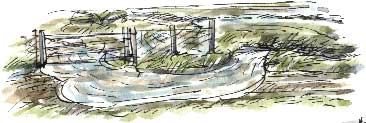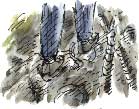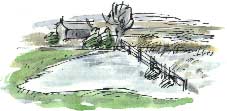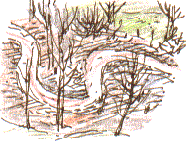 WATER
IS BUBBLING up under the gate, spilling out onto the path and flowing down
to the stream ten yards away. Perhaps, as they were taking the mechanical
digger in to fell some of the bankside crack willows recently,
the old drain beneath collapsed. It must be quite a blockage because it appears
that most of the flow has been forced above ground. The overflow will soon cut
it's own channel. It's only a few months since workmen repaired the potholes
caused when
a torrent of floodwater came down this footpath in June 2007.
WATER
IS BUBBLING up under the gate, spilling out onto the path and flowing down
to the stream ten yards away. Perhaps, as they were taking the mechanical
digger in to fell some of the bankside crack willows recently,
the old drain beneath collapsed. It must be quite a blockage because it appears
that most of the flow has been forced above ground. The overflow will soon cut
it's own channel. It's only a few months since workmen repaired the potholes
caused when
a torrent of floodwater came down this footpath in June 2007.
 Coxley Dam
Coxley Dam
Water finds a way and there’s
been a lot of it around this week, though nowhere near like the deluge we had
last summer. The two overflow channels from the earthen wall of Coxley Dam
seem to be flowing
more freely than is normal.
 Woodland
Path
Woodland
Path
The
usual muddy patch at the entrance to the wood is more extensive and even gloopier
than usual, sucking at our boots as we
sink ankle deep into it.
 Addingford
Addingford
The
small flash at the end of the long narrow pasture between the canal and river
has extended to take in half of an adjacent paddock.
Eggs-traordinary Energy
Like water, energy flows through the natural world; an ecologist might chart
the flow of energy from the sun, linking plants, herbivores and predators in
a food chain or food web. Our success as a species owes a lot to our ingenuity
in diverting some of the
energy flowing through
the
biosphere in our direction. In Jamie Oliver’s Fowl Dinners on
Channel 4 yesterday, the chef/food campaigner quoted these statistics:





-
If you
piled up all the chickens that we eat in the UK each year, the pile would
reach two-thirds of the way to the moon.
-
Line up the
eggs we consume in the UK each year end-to-end and they would stretch
around the Earth at the equator 15 times.
Waterworld
 Just
as we divert the flow of energy in the food chain for our own use, we divert
the energy flowing through the water cycle, channelling water away from land
we need for agriculture
or housing and impounding it to create a store of potential energy – for
example, here at the old mill dam in Coxley Valley, which was originally used
to power
a water wheel.
Just
as we divert the flow of energy in the food chain for our own use, we divert
the energy flowing through the water cycle, channelling water away from land
we need for agriculture
or housing and impounding it to create a store of potential energy – for
example, here at the old mill dam in Coxley Valley, which was originally used
to power
a water wheel.
The flow of the sun’s
energy through a landscape links the plants, animals and fungi that live there
but the shape of the landscape
itself is – in this valley and throughout much of the country – largely
an expression of the way water flows through it. The water cycle is also powered
by the sun’s
energy,
along with the force of gravity.
Taming the Flood
 Clearing
willows from this hollow will improve the flow of water through the valley
but it also means that the sponge-like
ability of willow branches, leaves,
roots and leaf litter to absorb each pulse of rainfall is diminished, so
there could now be an increased risk of flash-flooding further downstream.
Clearing
willows from this hollow will improve the flow of water through the valley
but it also means that the sponge-like
ability of willow branches, leaves,
roots and leaf litter to absorb each pulse of rainfall is diminished, so
there could now be an increased risk of flash-flooding further downstream.
The National River Authority
was informed by local councillors and residents of the history of flooding
in the valley before the recent Coxley Dell housing development went ahead.
The NRA raised no objections but building houses
a few hundred yards downstream from the old Coxley Mill dam (reconstructed
in
the
1970s or
1980s) - a structure designed to store potential energy - isn’t entirely
without its risks.
 WATER
IS BUBBLING up under the gate, spilling out onto the path and flowing down
to the stream ten yards away. Perhaps, as they were taking the mechanical
digger in to fell some of the bankside crack willows recently,
the old drain beneath collapsed. It must be quite a blockage because it appears
that most of the flow has been forced above ground. The overflow will soon cut
it's own channel. It's only a few months since workmen repaired the potholes
caused when
a torrent of floodwater came down this footpath in June 2007.
WATER
IS BUBBLING up under the gate, spilling out onto the path and flowing down
to the stream ten yards away. Perhaps, as they were taking the mechanical
digger in to fell some of the bankside crack willows recently,
the old drain beneath collapsed. It must be quite a blockage because it appears
that most of the flow has been forced above ground. The overflow will soon cut
it's own channel. It's only a few months since workmen repaired the potholes
caused when
a torrent of floodwater came down this footpath in June 2007. Coxley Dam
Coxley Dam Woodland
Path
Woodland
Path Addingford
Addingford
 Just
as we divert the flow of energy in the food chain for our own use, we divert
the energy flowing through the water cycle, channelling water away from land
we need for agriculture
or housing and impounding it to create a store of potential energy – for
example, here at the old mill dam in Coxley Valley, which was originally used
to power
a water wheel.
Just
as we divert the flow of energy in the food chain for our own use, we divert
the energy flowing through the water cycle, channelling water away from land
we need for agriculture
or housing and impounding it to create a store of potential energy – for
example, here at the old mill dam in Coxley Valley, which was originally used
to power
a water wheel. Clearing
willows from this hollow will improve the flow of water through the valley
but it also means that the sponge-like
ability of willow branches, leaves,
roots and leaf litter to absorb each pulse of rainfall is diminished, so
there could now be an increased risk of flash-flooding further downstream.
Clearing
willows from this hollow will improve the flow of water through the valley
but it also means that the sponge-like
ability of willow branches, leaves,
roots and leaf litter to absorb each pulse of rainfall is diminished, so
there could now be an increased risk of flash-flooding further downstream.